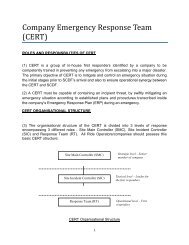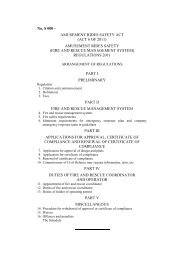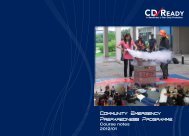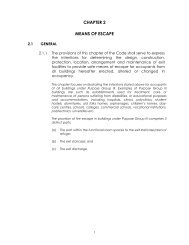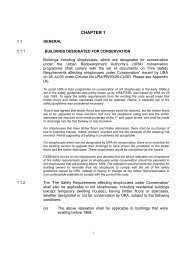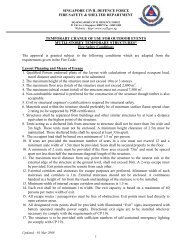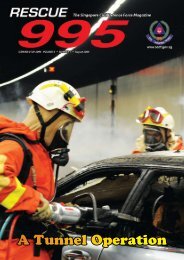Standard for Fire Safety in Rapid Transit Systems - Singapore Civil ...
Standard for Fire Safety in Rapid Transit Systems - Singapore Civil ...
Standard for Fire Safety in Rapid Transit Systems - Singapore Civil ...
You also want an ePaper? Increase the reach of your titles
YUMPU automatically turns print PDFs into web optimized ePapers that Google loves.
2.1.2.16 A space enclosed by elements of a station (<strong>in</strong>clud<strong>in</strong>g a<br />
suspended ceil<strong>in</strong>g or raised floor) or conta<strong>in</strong>ed with<strong>in</strong> an<br />
element but not a room, cupboard, circulation space,<br />
protected shaft or space with<strong>in</strong> a flue, chute, duct, pipe or<br />
conduit.<br />
2.1.2.17 A passage provid<strong>in</strong>g means of access from rooms or spaces<br />
to an exit.<br />
2.1.2.18 Critical velocity means the m<strong>in</strong>imum steady-state velocity of<br />
the ventilation airflow mov<strong>in</strong>g toward the fire with<strong>in</strong> a tunnel<br />
or passageway that is required to prevent backlayer<strong>in</strong>g at the<br />
fire site.<br />
2.1.2.19 The cubical extent of a station or compartment shall be<br />
ascerta<strong>in</strong>ed by measur<strong>in</strong>g the volume of space conta<strong>in</strong>ed<br />
with<strong>in</strong> the station or compartment :<br />
(a) The <strong>in</strong>ner f<strong>in</strong>ished surfaces of the enclos<strong>in</strong>g walls or,<br />
on any side where there is no enclos<strong>in</strong>g walls, a plane<br />
extend<strong>in</strong>g vertically above the outermost edge of the<br />
floor on that side,<br />
(b) The upper surface of its lowest floor, and<br />
(c) In the case of a station or compartment which extends<br />
to a roof, the under surface of the roof or, <strong>in</strong> the case<br />
of any other compartment, the under surface of the<br />
ceil<strong>in</strong>g of the highest storey with<strong>in</strong> the compartment,<br />
<strong>in</strong>clud<strong>in</strong>g the space occupied by any other wall, or any<br />
unprotected shafts, ducts or structure with<strong>in</strong> the space<br />
to be so measured, but exclud<strong>in</strong>g protected lift walls,<br />
exit staircases and other accommodation (such as<br />
lavatory and locker rooms) which are enclosed with<br />
walls hav<strong>in</strong>g fire resistance of not less than one hour<br />
and open<strong>in</strong>gs protected by doors of one half hour fire<br />
resistance fitted with automatic self-clos<strong>in</strong>g device.<br />
2.1.2.20 A dead-end is a situation with<strong>in</strong> a space, normally a corridor<br />
or lift lobby spaces, where exit is only possible from one end,<br />
with no possible escape from the other end.<br />
2.1.2.21 Detra<strong>in</strong><strong>in</strong>g load means the number of passengers alight<strong>in</strong>g<br />
from a tra<strong>in</strong> at a plat<strong>for</strong>m.<br />
Concealed<br />
space (cavity)<br />
Corridor<br />
Critical<br />
velocity<br />
Cubical extent<br />
of station or<br />
compartment<br />
Dead-end<br />
Detra<strong>in</strong><strong>in</strong>g load<br />
<strong>Standard</strong> <strong>for</strong> <strong>Fire</strong> <strong>Safety</strong> <strong>in</strong> <strong>Rapid</strong> <strong>Transit</strong> <strong>Systems</strong> 6





